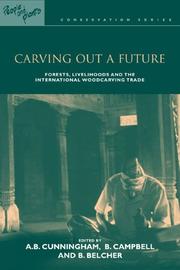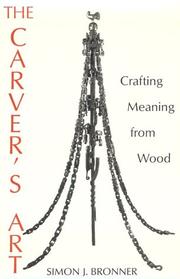| Listing 1 - 10 of 17 | << page >> |
Sort by
|
Book
Year: 2006 Publisher: [Place of publication not identified] : KIT Scientific Publishing,
Abstract | Keywords | Export | Availability | Bookmark
 Loading...
Loading...Choose an application
- Reference Manager
- EndNote
- RefWorks (Direct export to RefWorks)
Gegenwärtig stehen für den Holzbau selbstbohrende Vollgewindeschrauben mit Längen bis zu 600 mm und Durchmessern bis zu 12 mm zur Verfügung, die ohne Vorbohren und damit schnell und wirtschaftlich ins Holz eingedreht werden können. Mit diesen Schrauben eröffnen sich zahlreiche Möglichkeiten, tragfähige und steife Holzverbindungen kostengünstig herzustellen bzw. Holz in gefährdeten Bereichen wirkungsvoll zu verstärken. Im Rahmen dieser Arbeit wurden auf der Grundlage zahlreicher Versuche die wichtigsten tragfähigkeitsrelevanten Parameter ermittelt, die für die Bestimmung der Tragfähigkeit von Holzverbindungen mit selbstbohrenden Schrauben notwendig sind.


ISBN: 184407045X 1136570160 9786610476152 1849770700 6000000227 128047615X 1423728378 9781849770705 9781423728375 9781844070459 Year: 2005 Publisher: Sterling, VA : Earthscan,
Abstract | Keywords | Export | Availability | Bookmark
 Loading...
Loading...Choose an application
- Reference Manager
- EndNote
- RefWorks (Direct export to RefWorks)
Very little has yet been written about the cultural or economic contributions of woodcarving to people's livelihoods or the consequences of felling hardwood and softwood trees for the international woodcarving trade. Carving Out a Future is the first examination of this trade and its critical links to rural livelihoods, biodiversity, conservation, forestry and the international trade regime. A range of case studies from Australia, Bali, India,Africa and Mexico provides a lens for examining the critical issues relating to the significant impacts of woodcarving on forests, conservation efforts,
Wood-carving industry --- Environmental aspects --- Woodworking industries
Book
Year: 2016 Publisher: Florence, Italy : Firenze University Press,
Abstract | Keywords | Export | Availability | Bookmark
 Loading...
Loading...Choose an application
- Reference Manager
- EndNote
- RefWorks (Direct export to RefWorks)
This volume presents the research work carried out in the field of survey and representation methodologies for the documentation and analysis of wooden buildings. Thanks to the investigations carried out within a European project financed by the 7th Framework Program, several traditional Karelian villages, reported in this publication as case studies, have been documented with the aim of drawing guidelines for the development of suitable methodological protocols for documentation, analysis , survey, census and representation of complex systems. The research lays the foundations for the definition of an updated modus operandi to support the operators who are engaged in restoration, protection and preservation projects of the wooden architectural heritage.
Architecture, Domestic. --- Building, Wooden. --- Wood-carving. --- Russia (Federation)
Book
ISBN: 0803249500 9781461948087 1461948088 1299993079 9781299993075 9780803249509 9780803240971 080324097X Year: 2013 Publisher: Lincoln, Nebraska : Baltimore, Md. : University of Nebraska Press, Project MUSE,
Abstract | Keywords | Export | Availability | Bookmark
 Loading...
Loading...Choose an application
- Reference Manager
- EndNote
- RefWorks (Direct export to RefWorks)
"Joseph Hillaire (Lummi, 1894-1967) is recognized as one of the great Coast Salish artists, carvers, and tradition-bearers of the twentieth century. In A Totem Pole History, his daughter Pauline Hillaire, Sca;lla-Of the Killer Whale (b. 1929), who is herself a well-known cultural historian and conservator, tells the story of her father's life and the traditional and contemporary Lummi narratives that influenced his work. A Totem Pole History contains seventy-six photographs, including Joe's most significant totem poles, many of which Pauline watched him carve. She conveys with great insight the stories, teachings, and history expressed by her father's totem poles. Eight contributors provide essays on Coast Salish art and carving, adding to the author's portrayal of Joe's philosophy of art in Salish life, particularly in the context of twentieth century intercultural relations. This engaging volume provides an historical record to encourage Native artists and brings the work of a respected Salish carver to the attention of a broader audience. "--
ART / Native American. --- Totem poles --- Indian wood-carving --- Indian artists --- Lummi Indians --- Totems --- Indians --- Wood-carving, Indian --- Wood-carving --- Artists, Indian --- Artists --- Lummas Indians --- Lumme Indians --- Lummie Indians --- Lumni Indians --- Coast Salish Indians --- Indians of North America --- Hillaire, Joe,
Book
ISBN: 152750428X 9781527504288 9781527504288 Year: 2017 Publisher: Newcastle upon Tyne, England : Cambridge Scholars Publishing,
Abstract | Keywords | Export | Availability | Bookmark
 Loading...
Loading...Choose an application
- Reference Manager
- EndNote
- RefWorks (Direct export to RefWorks)
Wood-carving. --- Wood-carving --- Choir stalls. --- Misereres (Seats) --- Stalls, Choir --- Church decoration and ornament --- Church furniture --- Whittling --- Wood-carving, Primitive --- Wood carvings --- Wood craft --- Woodcarving --- Woodcraft --- Carving (Decorative arts) --- Woodwork --- Wood sculpture
Book
ISBN: 1315430592 1315430614 1315430606 1598747894 9781598747898 9781315430607 9781598743098 9781598743104 1598743090 1598743104 1315430584 Year: 2007 Publisher: Walnut Creek, Calif. : Left Coast Press,
Abstract | Keywords | Export | Availability | Bookmark
 Loading...
Loading...Choose an application
- Reference Manager
- EndNote
- RefWorks (Direct export to RefWorks)
This book argues for an important shift in cultural heritage conservation, away from a focus on maintaining the physical fabric of material culture toward the impact that conservation work has on people's lives. In doing so, it challenges the commodification of sacred objects and places by western conservation thought and attempts to decolonize conservation practice. To do so, the authors examine conservation activities at Maori marae-meeting houses-located in the US, Germany, and England and contrasts them with changes in marae conservation in New Zealand. A key case study is the Hinemih
Architecture, Māori --- Wood-carving, Māori --- Māori (New Zealand people) --- Cultural property --- Protection --- Material culture --- Architecture, Maori --- Wood-carving, Maori --- Maori (New Zealand people) --- Architecture, Māori --- Wood-carving, Māori --- Māori (New Zealand people)
Book
ISBN: 9781477318805 9781477318812 9781477318829 9781477318836 1477318828 1477318836 1477318801 147731881X Year: 2019 Publisher: Austin, Texas : University of Texas Press,
Abstract | Keywords | Export | Availability | Bookmark
 Loading...
Loading...Choose an application
- Reference Manager
- EndNote
- RefWorks (Direct export to RefWorks)
"Unlike many other handicrafts in the Mexican state of Oaxaca, which have long cultural and historical trajectories, Oaxacan woodcarving began in the second half of the twentieth century and has always been done for the commercial market. In The Value of Aesthetics, Alanna Cant explores how one family's workshop in the village of San Martín Tilcajete has become the most critically and economically successful, surpassing those of neighbors who use similar materials and techniques. The dominance of this family is tied to their ability to produce a new aesthetic that appeals to three key 'economies of culture': the tourist market for souvenirs, the national market for traditional Mexican artesanías, and the international market for indigenous art. Offering a new analytical model by which anthropologists can approach visual aesthetics and conceptualize the power of artworks as socially active objects, The Value of Aesthetics shows how aesthetic practices produce and redefine social and political relationships. By investigating the links between aesthetics and issues of production, authorship, ownership, and identity, Cant shows aesthetic change to be a process that ultimately repackages everyday life into commodified objects in Oaxaca."--
Applied arts. Arts and crafts --- Oaxaca --- Indian wood-carving --- Wood-carving industry --- Aesthetics --- Culture --- Indians of Mexico --- Economic aspects --- Material culture --- Mexico

ISBN: 0813147867 9780813147864 0813108632 9780813108636 081318729X 9780813187297 Year: 1996 Publisher: Lexington, Kentucky : The University Press of Kentucky,
Abstract | Keywords | Export | Availability | Bookmark
 Loading...
Loading...Choose an application
- Reference Manager
- EndNote
- RefWorks (Direct export to RefWorks)
Chains carved from a single block of wood, cages whittled with wooden balls rattling inside -- all ""made with just a pocketknife"" -- are among our most enduring folk designs. Who makes them and why? what is their history? what do they mean for their makers, for their viewers, for our society? Simon J. Bronner portrays four wood carvers in southern Indiana, men who had been transplanted from the rural landscapes of their youth to industrial towns. After retiring, they took up a skill they remembered from childhood. Bronner discusses how creativity helped these men adjust to change and how vie
Chains --- Folk art --- Wood-carving --- Wood-carvers --- Links and link-motion --- Peasant art --- Popular art --- Art --- Art, Primitive --- Whittling --- Wood-carving, Primitive --- Wood carvings --- Wood craft --- Woodcarving --- Woodcraft --- Carving (Decorative arts) --- Woodwork --- Wood sculpture --- Woodcarvers --- Woodworkers --- Folklore. --- Psychological aspects. --- Interviews.
Book
ISBN: 2895443289 1435698754 9781435698758 Year: 2007 Publisher: Quebec City : Editions MultiMondes,
Abstract | Keywords | Export | Availability | Bookmark
 Loading...
Loading...Choose an application
- Reference Manager
- EndNote
- RefWorks (Direct export to RefWorks)
Animal sculpture. --- Wood-carving --- Whales in art. --- Whittling --- Wood-carving, Primitive --- Wood carvings --- Wood craft --- Woodcarving --- Woodcraft --- Carving (Decorative arts) --- Woodwork --- Wood sculpture --- Animals in art --- Sculpture --- Models. --- Technique.
Book
ISBN: 1477318828 147731881X 1477318801 9781477318829 Year: 2019 Publisher: Austin, Texas : University of Texas Press,
Abstract | Keywords | Export | Availability | Bookmark
 Loading...
Loading...Choose an application
- Reference Manager
- EndNote
- RefWorks (Direct export to RefWorks)
Unlike many other handicrafts in the Mexican state of Oaxaca, which have long cultural and historical trajectories, Oaxacan woodcarving began in the second half of the twentieth century and has always been done for the commercial market. In The Value of Aesthetics, Alanna Cant explores how one family’s workshop in the village of San Martín Tilcajete has become the most critically and economically successful, surpassing those of neighbors who use similar materials and techniques. The dominance of this family is tied to their ability to produce a new aesthetic that appeals to three key “economies of culture”: the tourist market for souvenirs, the national market for traditional Mexican artesanías, and the international market for indigenous art. Offering a new analytical model by which anthropologists can approach visual aesthetics and conceptualize the power of artworks as socially active objects, The Value of Aesthetics shows how aesthetic practices produce and redefine social and political relationships. By investigating the links between aesthetics and issues of production, authorship, ownership, and identity, Cant shows aesthetic change to be a process that ultimately repackages everyday life into commodified objects in Oaxaca.
Indian wood-carving --- Wood-carving industry --- Aesthetics --- Culture --- Indians of Mexico --- Economic aspects --- Material culture --- Indians of North America --- Indigenous peoples --- Meso-America --- Meso-American Indians --- Mesoamerica --- Mesoamerican Indians --- Pre-Columbian Indians --- Precolumbian Indians --- Ethnology --- Cultural sociology --- Sociology of culture --- Civilization --- Popular culture --- Beautiful, The --- Beauty --- Esthetics --- Taste (Aesthetics) --- Philosophy --- Art --- Criticism --- Literature --- Proportion --- Symmetry --- Woodworking industries --- Indians --- Wood-carving, Indian --- Wood-carving --- Social aspects --- Psychology --- Radio broadcasting Aesthetics
| Listing 1 - 10 of 17 | << page >> |
Sort by
|

 Search
Search Feedback
Feedback About UniCat
About UniCat  Help
Help News
News